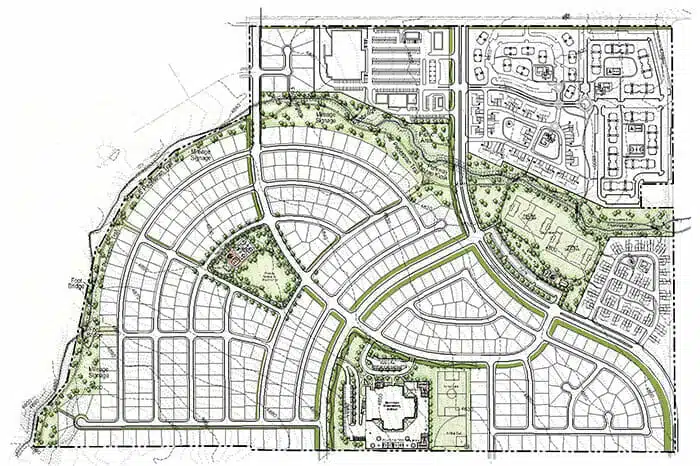Early city founders were the first American land planners when they would lay out in detail the streets and areas of their new cities and regulate how the land would be used. But formal zoning laws didn’t really exist until 1916 when New York City became the first to enact an ordinance that was the first comprehensive zoning law.
And that law came about all because of a single skyscraper . . . the Equitable Building.
One critic called this building a “monstrous parasite on the veins and arteries of New York.” Neighbors of the Equitable Building hated the skyscraper’s shape and scale so much that they filed reduced property valuation assessments because their property fell under the large shadow the building cast. The resulting public criticism led city officials to enact a change.
Opposition to the super-tall building was only one of the catalysts for zoning laws. New York City wasn’t the first to wrestle with the problem of zoning ordinances. Other cities were in the process of answering how to use their land best to protect the public and balance the rights of the public with the rights of the landowners.
The rest of the nation soon followed, and modern zoning laws came to fruition.
Where Land Planning and Zoning Laws Are Today
All real estate in the United States is regulated through land use regulations and zoning laws. Zoning is the most common form of land-use regulation used by cities and municipalities to control and direct real estate development within their borders.
There’s a difference between land planning, land use, and zoning. Many people believe they are one and the same; however, land planning and land use are how people adapt the land to suit their needs, whereas zoning is how the government regulates the land.
Did you know? Land-use and land planning regulation doesn’t just control existing buildings and uses – it guides future development.
Now that we’re clear on the difference between the two let’s chat about how it affects you – a potential buyer and developer of real estate.
How Zoning Laws and Land Use Regulations Affect You
If it were as easy as buying a piece of land, designing and building a beautiful building anywhere you wanted, you wouldn’t be reading this blog.
However, before purchasing a plot of land and beginning the building process, you must determine if you can before bidding.
It all starts with the master plan. Most cities and municipalities follow a comprehensive land plan that considers future land planning. In many cases, they’ve created an official map that outlines zoning, subdivision developments, street plans, public facilities, and other building regulations.
The city or municipality will be divided into residential, commercial, and industrial zones.
All these will affect what property you can buy and how you use that property.
But there’s more.
Not only must you consider the building you will place on the property and how you’ll use it, you must also follow additional restrictions unique to each municipality and area.
These restrictions may include:
- Specific requirements for the type of buildings allowed
- Location of utility lines
- Restrictions on accessory buildings
- Building setbacks from the streets
- Boundaries
- Size and height of the building
- Number of rooms
- Frontage of lots
- Minimum lot area
- Side yards
- Off-street parking
- Historical or cultural site preservation
- Ecological considerations
The list can be varied and extensive, so before you buy, you must check all zoning regulations to ensure you can do what you want with the property. Learn more about the details that go into land use planning.
Types of Land Uses
There are several types of land use in urban areas, each with specific designations and rules. The top seven types of land uses include:
Residential
This type of land use regulates where people live. This is one of the more complex designations since there are different types of regulations regarding density and types of residences that are allowed to be built from low-density (houses), medium-density (townhouses), and high-density (apartment buildings). A separate category allows for mixed-use development with a mix of residential, commercial, and recreational.
Transportation
Used to help people get from one destination to another. It’s not just streets and railways but the buildings associated with those activities, such as airports, train stations, and subway stations.
Commercial
This is another designation with separate “sub-designations” as well. Commercial land use may be warehouses, office buildings, restaurants, shops, or other commerce-type buildings.
Agricultural
Where residential regulations may restrict the number and types of animals on the property, agricultural land allows for the growing and harvesting of crops and livestock such as farms, ranches, and pastures.
Industrial
This type of land use includes factories, warehouses, and shipping yards. Industrial use may be limited by types of industry and environmental concerns.
Public Use
Hospitals, schools, and municipal buildings land in this category as well as churches. These areas are set aside for general public use.
Recreational
This land is set aside for parks, golf courses, open spaces, athletic fields, playgrounds, and swimming pools.
View our portfolio to view various examples of each type of land use and how Think Architecture designed each land plan and structure.
Types of Land Use Zoning
When city planners map out the city plan, they characterize each land use zone, affecting urban development. There are four types of land planning and land use zoning:
Functional Zoning
The seven types of zones outlined above exemplify functional zoning. Each zone is defined according to its function – commercial, residential, industrial, etc. Each has rules and regulations about the types of buildings and activities that can be built.
Form-based Zoning
This is zoning based on physical characteristics or urban identity. Think of “downtown” areas.
Intensity Zoning
Defined by the level of permitted intensity. Reflect on the residential land use split between high, medium, and low-density housing. This is an example of intensity zoning, where a certain number of residential units are allowed per surface unit.
Incentive Zoning
Economically depressed areas are often part of revitalization or development plans. Developers are incentivized to build new buildings and areas through tax abatements or light rail infrastructure.
Whew! If that weren’t enough to keep track of, there’s more!
Non-Government Restrictions: Restrictive Covenants and Easements
As if zoning laws and land use restrictions weren’t enough, you could be contending with restrictive covenants and easements placed on the property by land developers or prior property owners on the deed.
What does that mean? Let’s dive into the description of each of these non-government restrictions:
Restrictive Covenants
These are provisions in a deed that limits the use of the property and prohibits certain uses. This could be placed on the deed by the previous owner but are most commonly used by developers to establish and plan communities. Community planning preserves the neighborhood’s character by establishing minimum house sizes, setback lines, and other aesthetic considerations.
Easements
An easement is the right to use another person’s property. In some cases, where a property is landlocked, an easement gives the property owner the right to access his property across another person’s property by building a road. Another type of easement might not allow someone to build on a parcel of land to preserve somebody’s view or to preserve open land for environmental reasons.
Yikes!
When it comes to purchasing real estate for business or development reasons, understanding the variety of zoning, land use regulations, covenants, and easements is critical before you write that check.
And this is where we can help.
How Think Architecture Can Help
Hiring us is the best first step you can take.
Our team has developed a spectrum of projects across all land-use zones, from municipal buildings to city parks to high-density residential and commercial buildings. We bring our experience to the table in land planning and can help you assess potential locations.
We have a deep understanding of how to manage each project and how to address each zoning regulation. Every parcel of land is unique, and we’re up to the challenge of understanding the various rules of each zone and designing a building that conforms to those regulations.
Consult with us on your next project by calling (801) 269-0055 or send Think Architecture a message.


